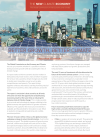
Documentos de Mitigación
La UE y América Latina y El Caribe ¿Preparando el camino hacia un nuevo acuerdo sobre el CC en 2015
Este artículo argumenta la forma en que las relaciones UE-ALC pueden constituir un cimiento sólido para dar impulso a un acuerdo justo, firme y ambicioso sobre el cambio climático en 2015, así como para fomentar el desarrollo de bajas emisiones de carbono en Europa y ALC.
This paper is an effort between researchers from different countries and with different backgrounds to achieve an agreed text on an important issue in the climate negotiations through a thought experiment of ‘think tank level negotiation’. It is a significant achievement for two groups of authors from China and Europe to have come this far.
 The emissions gap report 2013
The emissions gap report 2013
The current report reviews the latest estimates of the emissions gap in 2020 and provides plentiful additional information relevant to the climate negotiations. With this fourth assessment of the gap between ambitions and needs, the United Nations Environment Programme seeks to inform governments and the wider public on how far the response to climate change has progressed over the past year, and thus whether the world is on track to meet the 2° C target.
Its report seeks to inform economic decision-makers in both public and private sectors, many of whom recognise the serious risks caused by climate change, but also need to tackle more immediate concerns such as jobs, competitiveness and poverty. The report brings
together evidence and analysis, learning from the practical experience of countries, cities and businesses across the world.
Climate protection as a word citizen movement
This special report therefore focuses on two main aspects and their interaction. First, the report investigates what strategic and operational elements a multilateral climate agreement should include if it is to have a realistic chance of having an impact big enough to overcome the stagnation of the past decade. Second, it highlights the rapidly growing importance of the contribution being made by civil- society alliances and actors and demonstrates this contribution using numerous examples.
Summary for policymakers
This Summary for Policymakers (SPM) follows the structure of the Working Group III report. The narrative is supported by a series of highlighted conclusions which, taken together, provide a concise summary. The basis for the SPM can be found in the chapter sections of the underlying report and in the Technical Summary (TS). References to these are given in square brackets.
.
 Español
Español English
English 





